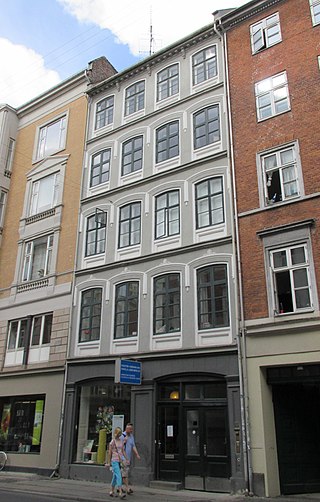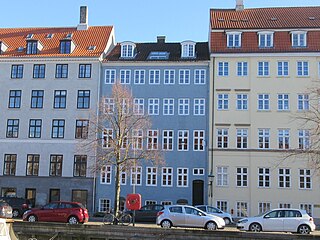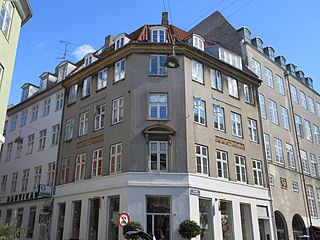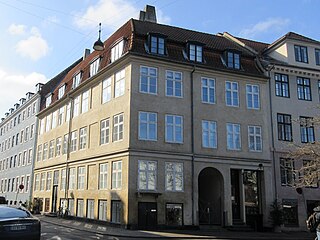
The Jennow House is a historic property located at Strandgade 12 in the Christianshavn neighbourhood of Copenhagen, Denmark. It takes its current name after Andreas Jennow, a businessman who owned it from 1949 to 1978. His company Andreas Jennow A/S was based in the building until 1988.

Frederiksholms Kanal 20, located at the corner with Ny Kongensgade, is a mid-19th century apartment building overlooking Frederiksholms Kanal in central Copenhagen, Denmark. Its current appearance dates from 1848 when a building from before 1750 was heightened with two floors. The neighbouring building at Ny Kongensgade 4 and a three-storey warehouse in the courtyard were also built at this point. All three buildings were listed on the Danish registry of protected buildings and places in 1959.

Ny Kongensgade 7 is a historic property in the small Frederiksholm Quarter of central Copenhagen, Denmark. It was listed on the Danish registry of protected buildings and places on 31 March 1931.

Ny Kongensgade 9 is a Neoclassical property located in the small Frederiksholm Neighborhood of central Copenhagen, Denmark. It consists of a three-storey building with mansard roof from 1804 towards the street, a six-bay side wing along the eastern margin of a courtyard and an older two-storey building at its rear. The building from 1804 with its six-bay side wing, was listed in the Danish registry of protected buildings and places in 1904. The low building in the courtyard is not listed.

Lille Strandstræde 3 is a Neoclassical property in the Nyhavn Quarter of central Copenhagen, Denmark. The building was listed in the Danish registry of protected buildings and places in 1979.

Højbro Plads 15 is a Neoclassical property situated on Højbro Plads in central Copenhagen, Denmark. The building was like most of the other buildings in the area constructed as part of the rebuilding of the city following the Copenhagen Fire of 1795. It was listed in the Danish registry of protected buildings and places in 1950.

Nybrogade 26 is a property overlooking Slotsholmen Canal in central Copenhagen, Denmark. It consists of a seven-bays-wide, four-storey residential building towards the canal and a former brewery building from the beginning of the 19th century at Magstræde 13 on the other side of the block. The entire complex was listed in the Danish registry of protected buildings and places in 1918. Notable former residents include the army officer and engineer Ernst Peymann (1737-1823). theologian Peter Rørdam (1806-1883) and mathematician and politician Adolph Steen (1816-1886).

Rådhusstræde 11 is an early 18th-century building on Rådhusstræde, between Gammeltorv-Nytorv and Frederiksholms Kanal, in the Old Town of Copenhagen, Denmark. It was listed in the Danish registry of protected buildings and places in 1945. The Supreme Court attorney Christian Klingberg lived in the building as a child.

Store Kongensgade 23 is a Neoclassical mixed-use building situated in Store Kongensgade in Copenhagen, Denmark. The building fronting the street was constructed by master mason Christian Olsen Aagaard in 1850. Aagaard had already constructed the adjacent building at No. 25 in 1837, whose ground floor hosted the Royal Court Pharmacy from 1950 until 1971. The two buildings share a courtyard on their rear. At the far end of the courtyard is a former silver factory constructed in 1887 by Bernhard Hertz according to his own design. The factory was decommissioned in 1942 and was later used as office space prior to being converted into apartments in 2018. Store Kongensgade 23 and the former silver factory were listed in the Danish registry of protected buildings and places in 1989. No. 25 is not listed.

Kringlegangen is a passageway linking the square Gråbrødretorv with the street Valkendorfsgade in the Old Town of Copenhagen, Denmark. A bakery was operated on the site from before 1787 until at least the 1910s. The present building complex was constructed in 1856-1857 for master joiner Carl Heinrich Winther. The passageway was not opened to the public until 1975. The name Kringlegangen was inspired by a gilded kringle above the entrance from Gråbrødretorv as well as to the twisting and turning course of the passageway. The entire building complex was listed in the Danish registry of protected buildings and places in 1945.

Nyhavn 47 is an 18th-century property situated at the corner of Nyhavn and Toldbodgade in central Copenhagen, Denmark. It owes its current appearance to a renovation undertaken by Julius Andreas Blom in 1842–45. It was listed in the Danish registry of protected buildings and places in 1932. Notable former residents include the merchant and shipowner Peter Christian Knudtzon.

Nyhavn 37 is an 18th-century property overlooking the Nyhavn Canal in central Copenhagen, Denmark. A distillery was from before 1756 until at least the 1860s operated in the yard. The building was listed in the Danish registry of protected buildings and places in 1923.

Kompagnistræde 24 is a Neoclassical property situated on Strædet, between Knabrostræde and R¨dhusstræde, in the Old Town of Copenhagen, Denmark. It was constructed as part of the rebuilding of the city following the Copenhagen Fire of 1795 and later heightened with one storey in 1849. The building was listed in the Danish registry of protected buildings and places in 1979. Notable former residents include the artist Janus Laurentius Ridter.

Ovengaden Oven Vandet 52 is a mid 19th-century residential building overlooking Christianshavn Canal in the Christianshavn neighborhood of central Copenhagen, Denmark. The building was constructed in 1772 but heightened in 1846. It was listed in the Danish registry of protected buildings and places in 1945. Notable former residents include the botanist Erik Viborg, diplomat and politician Valdemar Rudolph von Raasløff and painter Edvard Weie.

Lille Strandstræde 8 is an 18th-century property situated around the corner from Nyhavn in central Copenhagen, Denmark. Constructed as a two-storey, half-timbered building for Andreas Bodenhoff in the middle of the century, it was later first reconstructed in brick and heightened with two storeys in 1783 and then, in 1932, expanded with a seven-bays-long side wing on the rear. The building was listed in the Danish registry of protected buildings and places in 1959. Notable former residents include the German painter Bernhard Mohrhagen and the veterinarian Viggo Stockfleth.

Læderstræde 36 is a Neoclassical building situated at the corner of Læderstræde and Hyskenstræde in the Old Town of Copenhagen, Denmark. The property was for around 100 years, from 1722 until some time after 1806 the site of a distillery. The adjacent building Hyskenstræde 9 was part of the same property until 1845. The two buildings were both constructed as part of the rebuilding of the city following the Copenhagen Fire of 1795, although the building in Hyskenstræde was subject to comprehensive alterations in 1834. The two buildings were individually listed in the Danish registry of protected buildings and places in 1964.

The Gerling House is a late 17th-century hibuilding complex complex situated at Strandgade 38 in the Christianshavn district of central Copenhagen, Denmark. It consists of a three-storey, four-bays-wide front wing towards the street and a 13-bays-long two-storey side wing on its rear. The master cooper Peter Richter established a cooper's workshop in the building in the 1830s and the property was after his death owned by his widow until 1880. The building was listed in the Danish registry of protected buildings and places in 1918. Notable former residents include the naval officer and painter Sophus Schack.

Fiolstræde 7 is a Neoclassical mixed-use building situated next to Hotel Sankt Petri on the west side of the pedestrianized shopping street Fiolstræde in the Old Town of Copenhagen, Denmark. The building was listed in the Danish registry of protected buildings and places in 1951. Notable former residents include theologian Christian Thorning Engelstoft (1805-1889), educator Conrad Krebs and artist Edvard Lehmann (1815-1892).

Fiolstræde 29 is a Neoclassical building situated on the shopping street Fiolstræde, roughly opposite Rosengården, in the Old Town of Copenhagen, Denmark. It was constructed by master carpenter Johan Christoffer Wahl as part of the rebuilding of the city following the British bombardment of Copenhagen in 1807. The building was listed on the Danish registry of protected buildings and places in 1951.

Lille Strandstræde 13–15 is a property situated at the corner of Lille Strandstræde and the small nameless square that is formed where the street joins Store Strandstræde on the south side of Sankt Annæ Plads in central Copenhagen, Denmark. The corner property was from at least the 1750s to circa 1890 owned by distillers. Their distillery was located on the upper floors of a still existing warehouse in the courtyard. The ground floor of the warehouse was used as cow stable. Part of the building fronting the street was also used by the distillery. No. 13 dates from 1852. No. 15 dates from 1758 but was refurbished in 1852. The entire complex was listed in the Danish registry of protected buildings and places in 1950. In front of the building is a small garden complex with a bronze cast of Otto Evens's 1859 statue Neapolitan Fisherman Teaches His Son to Play the Flute.























